Suillus Adans.
A number of species are known in Europe. Fruitbody boletoid without or with partial veil, and then leaving a ring on the stipe. Cap in most species more or less viscid. Stipe solid.
Suillus lakei (Murrill) A.H. Sm. & Thiers
Description
Fruitbodies with partial veil, soon disrupting and leaving a ring in the upper part of the stipe. Cap up to 10 cm, with fine appressed scales, rusty to pale brown, usually dry, rarely viscid. Stipe cylindrical or slightly swollen below, solid, straw or yellowish, darkening in the lower parts, below the tubes with a distinct ring. Flesh yellowish to yellowish-white, somewhat greenish in the stipe, mostly unchanging when exposed to air, or sometimes reddening in the cap or slightly blueing in the stipe. Tubes short, decurrent, durty yellow to rusty yellowis. Pores large, angular, concolorous with the tubes, darkening when bruised. Smell not distinctive. Taste not distinctive. Spores 9–12 × 3.5–5 μm.
Habitat. Plantations of Douglas’ fir (Pseudotsuga), with which tree the fungus is strictly mycorrhizal.
Distribution. North American fungus, in Europe introduced through its mycorhizal host, and currently known in Bosna and Herzegovina, Bulgaria, Czech Republic, Denmark, Germany, Hungary, Italy (incl. Sicily), Slovakia, and UK.
Similarity. Although confusion is highly unlikely, compare with Boletinus cavipes, which has hollow stipe and unchanging flesh, and grows under larch (Larix). In North America there are some other Suillus species growing under Douglas’ fir (S. caerulescens A.H. Sm. & Thiers, S. ponderosus A.H. Sm. & Thiers). However none of them have been found in Europe so far.
Note. Some European authors (e.g. Watling & Hills 2005) prefer to use the name Suillus amabilis (Peck) Singer. There has been much discussion in the mycological literature whether S. lakei and S. amabilis should be considered identical. See Singer (1966), Smith & Thiers (1967), Thiers (1975; available online).
Photographs
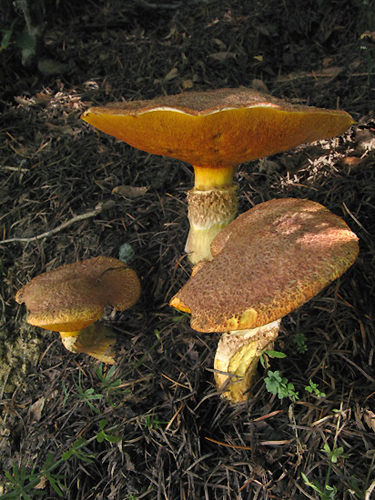
Fruitbodies of Suillus lakei. (photo I. Assyova)
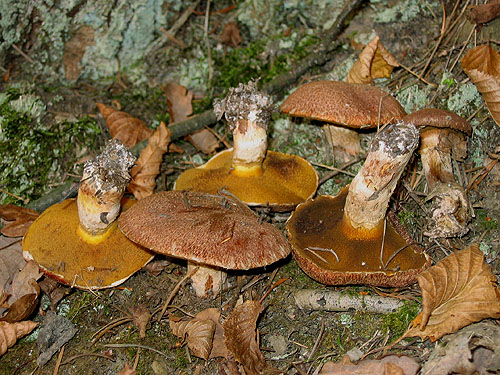
Fruitbodies of Suillus lakei. (photo B. Assyov)
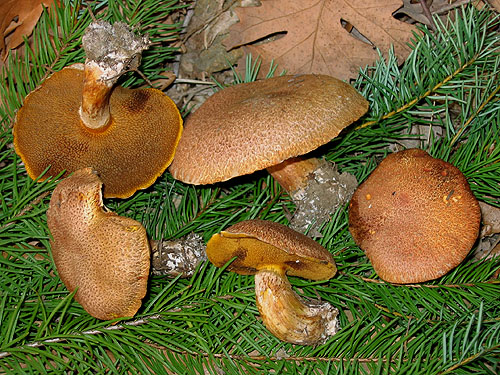
Fruitbodies of Suillus lakei. (photo B. Assyov)
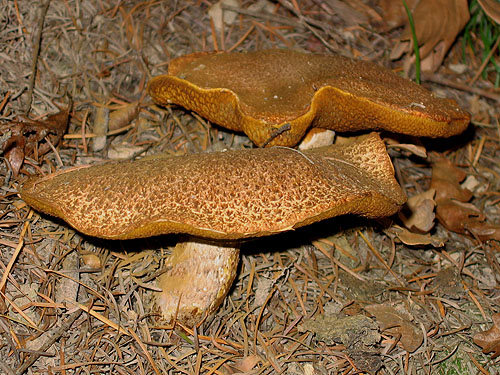
Old fruitbodies of Suillus lakei. (photo B. Assyov)

Suillus lakei - detail of the cap surface. (photo B. Assyov)

Suillus lakei - detail of the stipe and the ring. (photo B. Assyov)
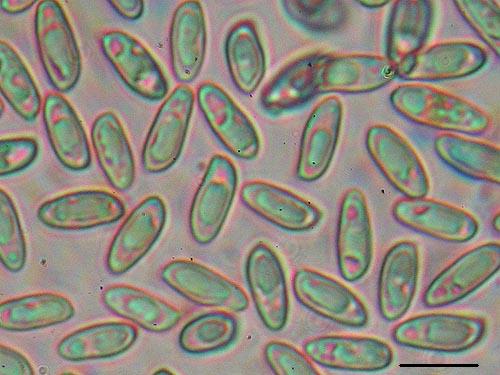
Basidiospores of Suillus lakei. Scale bar = 10 μm. (photo B. Assyov)
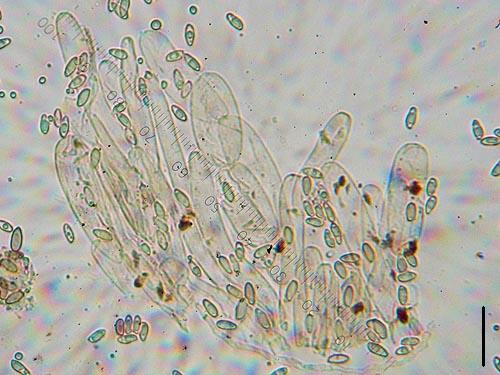
Pileipellis of Suillus lakei - hyphae of the scales. Scale bar = 50 μm. (photo B. Assyov)
Important literature
Assyov, B., Stoichev, G. & Vassilev, R. 2006. First records of mushroom species for Bulgaria. – Mycologia Balcanica 3: 127–130. (available online)
Engel, H., Dermek, A., Klofac, W., Ludwig, E. & Brückner, T. 1996. Schmier – und Filzröhrlinge s. l. in Europa. Die Gattungen Boletellus, Boletinus, Phylloporus, Suillus, Xerocomus. Verlag Heinz Engel, Weidhausen b. Coburg.
Estadès, A. & Lannoy, G. 2004. Les bolets européens. – Bulletin Mycologique et Botanique Dauphiné-Savoie 44(3): 3–79.
Galli, R. 1998. I Boleti. Atlante pratico-monographico per la determinazione dei boleti. Edinatura, Milano.
Knudsen, H. & Vesterholt, J. [eds.]. 2008. Funga Nordica. Nordsvamp, Kopenhagen.
Lannoy, G. & Estadès, A. 2001. Les Bolets. Flore mycologique d’Europe. Documents Mycologiques Mémoire Hors série no. 6. Pp. 1–163. Association d’Écologie et de Mycologie, Lille.
Lavorato, C. 1997. Osservazioni tassonomiche su Suillus lakei. – Bolletino del Gruppo Micologico Bresadola – Nuova serie 40: 285–290. (available online as MS Word document)
Lavorato, C. 2000. Suillus lakei var. calabrus var. nov.– In: Micologia 2000. Pp. 285–288. Associazone Micologica Bresadola, Trento. (available online as MS Word document)
Muñoz, J.A. 2005. Boletus s. l. – In: Fungi Europaei. Vol. 1. Pp. 1–951. Edizioni Candusso, Alassio.
Pilát, A. & Dermek, A. 1974. Hríbovité huby. Československé hríbovité a sliziakovité huby (Boletaceae – Gomphidiaceae). Veda, Bratislava.
Singer, R. 1966. The type of Boletus amabilis. – Mycologia 58: 157–159.
Smith, A.H. & Thiers, H.D. 1967. Comments on Suillus amabilis and Suillus lakei. – Mycologia 59: 361–367.
Šutara, J., Mikšík, M. & Janda, V. 2009. Hřibovité houby. Čeled’ Boletaceae a rody Gyrodon, Gyroporus, Boletinus a Suillus. Academia, Praha.
Thiers, H.D. 1975. California Mushrooms. A Field Guide to the Boletes. Hafner Press, New York. (available online as HTML)
Watling, R. & Hills, A.E. 2005. Boletes and their allies (revised and enlarged edition). – In: Henderson, D.M., Orton, P.D. & Watling, R. [eds]. British Fungus Flora. Agarics and boleti. Vol. 1. Royal Botanic Garden, Edinburgh.